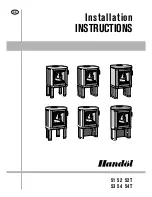
Regency CLASSIC C33-2 Freestanding Gas Stove
11
Diagram 2
LOG SET
INSTALLATION
WARNING: Dangerous operating
conditions may occur if these logs
are not positioned in their approved
locations. Read the instructions
below carefully and refer to the
diagrams. If logs are broken do not
use the unit until they are replaced.
Broken logs can interfere with the
pilot and burner operation.
Diagram 1
TEST FOR FLUE
SPILLAGE
This heater must be properly connected to a
venting system.
WARNING: Operation of this heater
when not connected to a properly
installed and maintained venting
system or tampering with the vent
safety shutoff system can result in
carbon monoxide (CO) poisoning
and possible death.
A “spillage” test must be made before the
installed unit is left with the customer. Follow
the procedure below:
INSTALLATION
Valve Description
1) Gas cock knob
2) Manual high/low adjustment
3) Pilot Adjustment
4) Thermocouple Connection
5) Main Operator
6) Outlet Pressure Tap
7) Inlet Pressure Tap
8) Pilot Outlet
9) Main Gas Outlet
10) Flange Securing Screw Holes
11) Alternative TC Connection Point
12) Thermoelectric Unit
13) Additional Valve Mounting Hole
1) Start all exhaust fans in the home and then
close all doors and windows in the room.
2) Light the unit and set controls to maximum.
3) After five minutes, test that there is a “pull”
on the flue by placing a smoke match,
cigarette or similar device which gives off
smoke, on the edge of the draft hood. See
Diagram below.
The smoke should be drawn into the draft hood.
If the smoke is still not drawn into the draft hood,
turn the unit off and check for the cause of the
lack of draft. If necessary, seek expert advice.
Note: If the flue is blocked or has a strong
reverse flow, the thermally actuat-
ed safety switch mounted in the
draft hood will automatically shut
off the gas supply in less than 10
minutes. If the heater turns off
because of this during the spillage
test, check for the cause of the lack
of draft and if necessary, seek
expert advice.
To reset the thermally actuated safety switch,
let the unit cool for 10 minutes, then press the
red reset button on the back of the switch. See
Diagram below.
The gas log kit contains the following:
a)
Front Log
b)
Rear Log
c )
Small Cross Logs (2)
d)
Bag of embers
e)
Bag of rock wool
1) Remove the logs from the box and carefully
unwrap them. The logs are fragile,
handle with care. Do not force into
position.
2) Place the rear deflector on the rear log
support pins in the back of the unit.
3) Place the rear log into the rear of the firebox,
aligning the holes on the underside of the log
with the rear log support pins and carefully
push the log down onto the pins. See
diagrams 1 and 2.
4) Ensure the front deflector is over front log
pins. See diagram 1.
5) Place the front log in the front of the unit,
aligning the holes on the underside of the log
with the log support pins in the front of the
unit. Carefully push the log down onto the
pins. See diagram 1.
6) Place the cross logs on top of the larger logs
aligning the holes on the underside of the
cross log with the log pins in the larger logs.
See diagrams 1 & 2. Carefully push the
cross logs onto the pins.
7) Distribute the embers along the mesh em-
ber tray, but do not cover the burner ports.
(Burner ports are the little holes on the top
of the burner tube.) Pull off ember size
pieces from the rock wool. Gently place the
pieces on top of the embers. See diagram
3.










































